Attached files
| file | filename |
|---|---|
| 8-K - FORM 8-K - COVANTA HOLDING CORP | c23423e8vk.htm |
| EX-99.1 - EX-99.1 - COVANTA HOLDING CORP | c23423exv99w1.htm |

| COVANTA HOLDING CORPORATION Q3 2011 EARNINGS CONFERENCE CALL October 20, 2011 Exhibit 99.2 |

| Cautionary Statements All information included in this earnings presentation is based on continuing operations. Forward-Looking Statements Certain statements in this presentation may constitute "forward-looking" statements as defined in Section 27A of the Securities Act of 1933 (the "Securities Act"), Section 21E of the Securities Exchange Act of 1934 (the "Exchange Act"), the Private Securities Litigation Reform Act of 1995 (the "PSLRA") or in releases made by the Securities and Exchange Commission ("SEC"), all as may be amended from time to time. Such forward- looking statements involve known and unknown risks, uncertainties and other important factors that could cause the actual results, performance or achievements of Covanta and its subsidiaries, or general industry or broader economic performance in global markets in which Covanta operates or competes, to differ materially from any future results, performance or achievements expressed or implied by such forward-looking statements. Statements that are not historical fact are forward-looking statements. Forward-looking statements can be identified by, among other things, the use of forward-looking language, such as the words "plan," "believe," "expect," "anticipate," "intend," "estimate," "project," "may," "will," "would," "could," "should," "seeks," or "scheduled to," or other similar words, or the negative of these terms or other variations of these terms or comparable language, or by discussion of strategy or intentions. These cautionary statements are being made pursuant to the Securities Act, the Exchange Act and the PSLRA with the intention of obtaining the benefits of the "safe harbor" provisions of such laws. Covanta cautions investors that any forward-looking statements made by Covanta are not guarantees or indicative of future performance. Important assumptions and other important factors that could cause actual results to differ materially from those forward-looking statements with respect to Covanta, include, but are not limited to, the risk that Covanta may not successfully close its announced or planned acquisitions or projects in development and those factors, risks and uncertainties that are described in periodic securities filings by Covanta with the SEC. Although Covanta believes that its plans, intentions and expectations reflected in or suggested by such forward-looking statements are reasonable, actual results could differ materially from a projection or assumption in any forward-looking statements. Covanta's future financial condition and results of operations, as well as any forward-looking statements, are subject to change and inherent risks and uncertainties. The forward-looking statements contained in this press release are made only as of the date hereof and Covanta does not have or undertake any obligation to update or revise any forward-looking statements whether as a result of new information, subsequent events or otherwise, unless otherwise required by law. Non-GAAP Financial Measures We use a number of different financial measures, both United States generally accepted accounting principles ("GAAP") and non-GAAP, in assessing the overall performance of our business. The non-GAAP financial measures of Adjusted EBITDA, Free Cash Flow and Adjusted EPS, as described and used in this earnings presentation, are not intended as a substitute or as an alternative to net income, cash flow provided by operating activities or diluted earnings per share as indicators of our performance or liquidity or any other measures of performance or liquidity derived in accordance with GAAP. In addition, our non-GAAP financial measures may be different from non-GAAP measures used by other companies, limiting their usefulness for comparison purposes. The presentations of Adjusted EBITDA, Free Cash Flow and Adjusted EPS are intended to enhance the usefulness of our financial information by providing measures which management internally use to assess and evaluate the overall performance of its business and those of possible acquisition candidates, and highlight trends in the overall business. In each case, a reconciliation to the nearest GAAP measure is provided. |

| Q3 2011 Highlights (Unaudited, in millions, except EPS) Q3 2011 Q3 2010 % Variance Revenue $432 $403 7% Adjusted EBITDA $152 $150 1% Free Cash Flow $106 $95 12% Adjusted EPS $0.24 $0.24 - Solid operating and financial results in line with expectations Returned $91 million of capital to shareholders Effectively managed the impact of Hurricane Irene Safely and reliably operated throughout Net financial impact immaterial Groundbreaking on Durham-York construction project 3 |

| Waste Market Update Current trends: full year pricing expected to be up 1 to 2% Q3 2011 Tip fee pricing and volume improved from prior year Demand trending positive; benefit in volume from wet weather Additional benefit in price from relatively high diesel/transportation costs Special waste program growth Medium-term outlook: anticipate growth at inflation rates Tip fee contract renewals: minimal net impact in 2012 Special waste business: expanding customer base and offerings Secure destruction services, manufacturing and production waste Opportunity in zero landfill and sustainability initiatives segments growing |

| Recycled Metals Market Update Current trends: pricing remains strong for 2011 Q3 2011 metals revenue: $20 million (up $7 million vs Q3 2010) YTD metals revenue: $55 million (up $14 million vs 2010) Medium-term outlook: improving recovered metals quantity and quality Capital investments to grow metals revenue Shredder at Dade facility already boosting metal purity and price Evaluating upgrades in capture/processing systems at other locations to gain volume scale and purity Metals revenue growth will continue to also depend on underlying commodity price Recycled metals pricing to be driven by emerging economies and global growth |

| Energy Market Update Current trends: CVA's energy portfolio stable in soft market Average exposed pricing thus far in 2011 generally consistent with expectations (excluding Long Island avoided cost rate decline) Biomass plants: lower contribution due to current "bark spread," but proactively addressing Medium-term outlook: forward curves indicate price increase Total 2012 energy production continues to be about 6 million MW-hr including biomass production Contracted and hedged production ~ 3.8 million MW-hr EfW production exposed to market ~ 1.5 million MW-hr Biomass production dispatched offline or exposed to market ~ 0.7 million MW-hr |

| Increasing Energy Generation at Market Current average contract + hedged price ~ low $70s/MW-hr EfW electricity average contract + hedged price ~ low $60s/MW-hr Expect minimal headwind from mark-to-market at expirations Biomass/renewable: above our average ? expect to re-contract at similar price EfW steam generation: above our average ? expect to re-contract at similar price EfW electricity contracted and hedged: below our average ? modest headwind Attractive locations Increasing share of energy revenue Upside from increasing generation at market Hard to replicate assets in good locations EfW facilities get paid for the fuel New policy initiatives may increase value 7 |

| Construction Initiatives Ongoing construction projects all on track Honolulu: expansion ~70% complete; start-up in 2012 China plants: Taixing and Chengdu now processing waste Durham-York (Ontario) Groundbreaking on August 17, 2011 First new large scale EfW project in North America in over 15 years Construction revenue (3 years) ? 20 year operating contract Artist Rendering of Completed Facility Honolulu Expansion Facility Week 3 Honolulu Expansion Facility Week 86 |

| Development Pipeline Update on UK development Not named preferred bidder on Leeds Smallest development opportunity in the portfolio Submitted a quality, disciplined bid focused on return on capital Received Rookery planning approval - important step but still much to be done First to be granted development consent from Infrastructure Planning Commission (IPC) EfW plant: ~585,000 annual tonnes turned into 65 MW-hr of electricity Merseyside "best & final" bid supporting Ince project due later this year Winner expected to be selected first half of 2012 Merseyside anchor client of proposed ~850,000 annual tonnes Ince project Update on UK environment UK waste policy very supportive of EfW; expectation of economic softness in near / medium term Artist Rendering of Ince Facility Artist Rendering of Rookery Facility |
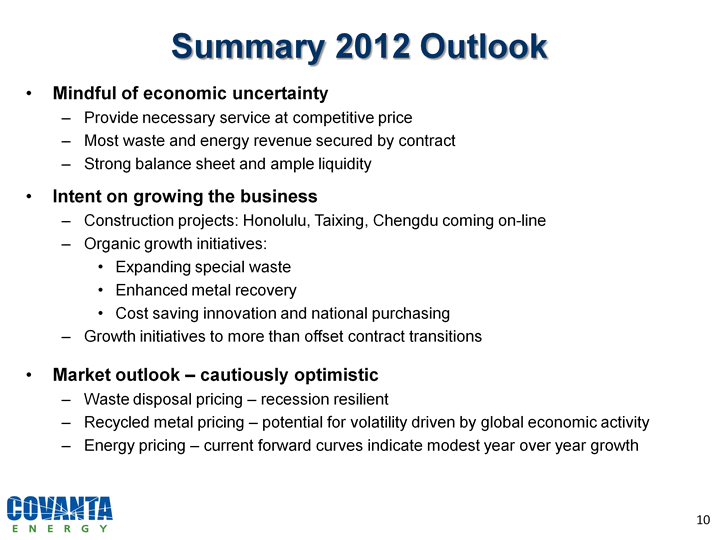
| Mindful of economic uncertainty Provide necessary service at competitive price Most waste and energy revenue secured by contract Strong balance sheet and ample liquidity Intent on growing the business Construction projects: Honolulu, Taixing, Chengdu coming on-line Organic growth initiatives: Expanding special waste Enhanced metal recovery Cost saving innovation and national purchasing Growth initiatives to more than offset contract transitions Market outlook - cautiously optimistic Waste disposal pricing - recession resilient Recycled metal pricing - potential for volatility driven by global economic activity Energy pricing - current forward curves indicate modest year over year growth Summary 2012 Outlook |

| Financial Overview |
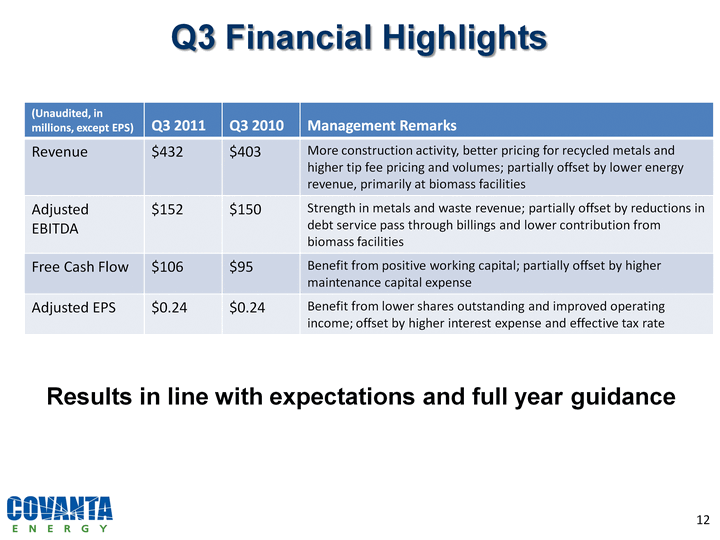
| Q3 Financial Highlights Results in line with expectations and full year guidance (Unaudited, in millions, except EPS) Q3 2011 Q3 2010 Management Remarks Revenue $432 $403 More construction activity, better pricing for recycled metals and higher tip fee pricing and volumes; partially offset by lower energy revenue, primarily at biomass facilities Adjusted EBITDA $152 $150 Strength in metals and waste revenue; partially offset by reductions in debt service pass through billings and lower contribution from biomass facilities Free Cash Flow $106 $95 Benefit from positive working capital; partially offset by higher maintenance capital expense Adjusted EPS $0.24 $0.24 Benefit from lower shares outstanding and improved operating income; offset by higher interest expense and effective tax rate |
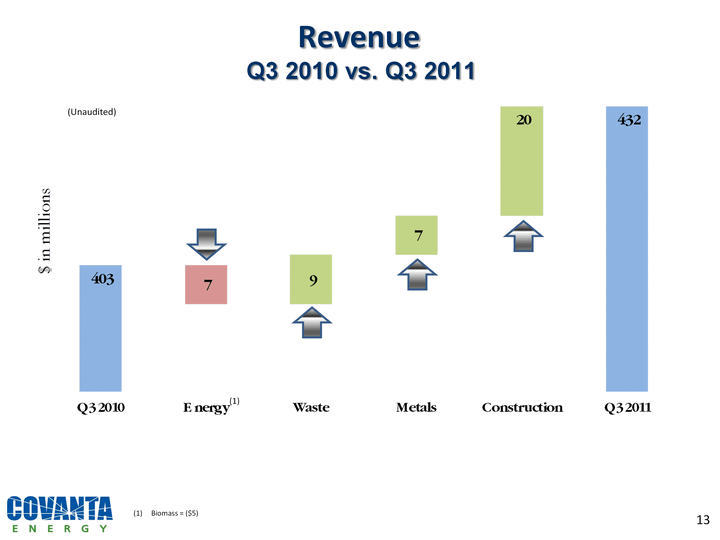
| Revenue Q3 2010 vs. Q3 2011 (1) Biomass = ($5) (Unaudited) |

| Adjusted EBITDA Q3 2010 vs. Q3 2011 (Unaudited) |

| Free Cash Flow Q3 2010 vs. Q3 2011 (Unaudited) |

| Adjusted EPS Q3 2010 vs. Q3 2011 (Unaudited) |

| Stable Revenues with Upside (CHART) (CHART) Q3 2011 TTM Actuals $1,070 million Q3 2011 TTM Actuals $405 million (CHART) Revenue mix between contracted and market allows for stability, with both upside and operational flexibility Waste & Service Revenues Energy Revenues |

| Current Free Cash Flow yield of approximately 13% (1) Sustainable: highly contracted and predictable business model Medium-term: core business growth and lower project debt interest offset contract transition impacts and higher corporate interest (from refinancing) Mid-decade: contract transition tailwinds and organic growth initiatives tend to offset NOL being fully utilized Upside: development projects and/or higher energy and commodity prices Portion of Free Cash Flow is dedicated to repaying project debt annually As project debt winds down, cash flow available increases for both growth and shareholder actions Alternatively, reducing project debt can be replaced with new corporate debt creating additional liquidity Sustainable Cash Generation (1) Computed at 9/30/11 by dividing the midpoint of our revised 2011 Free Cash Flow guidance range ($275 million) by our market capitalization, which represents the closing price per share ($15.19) multiplied by the number of shares outstanding (138 million). 18 |

| Capital Return Activities Q3 2011 return of $91 million to shareholders $81 million of stock repurchased: ~5 million shares (4% of shares outstanding) Funded from Free Cash Flow and Asia IPP asset sale proceeds $10 million in dividends declared $0.075 per quarter; $0.30 per share annualized $USD millions Returned $565 million to shareholders since June 2010; repurchased 12% of shares outstanding; share buyback authorization increased by additional $100 million during Q3 |

| Capitalization Summary Balance sheet remains strong; ample liquidity Repaid a total of $120 million of debt YTD Over last 5 years, paid down over $800 million of project debt, continuing to increase overall financial flexibility Funding shareholder capital returns with ongoing cash flow, not pressuring the balance sheet Debt balances are presented at principal value, not book value. Net debt is calculated as total principal amount of debt outstanding less cash & cash equivalents and debt service principal-related restricted funds. Ratio is computed on a consolidated basis and differs from the calculation required under Covanta's credit facility. Capitalization is calculated as total debt outstanding plus stockholders' equity. |

| Q4 2011 outlook consistent with prior commentary Stronger Adjusted EBITDA Planned maintenance activity lower, due to more work done in Q2 2011 Improved year-over-year operating performance Free Cash Flow expected to be down Increase in Adjusted EBITDA offset by the semi-annual high-yield interest payment and significantly lower working capital generation Q4 2011 Outlook |

| 2011 Guidance Update Narrowing full year 2011 guidance ranges Adjusted EBITDA: increased metals and improved operations more than offsets lower biomass contribution and debt service billings decline Free Cash Flow: another strong year; reduction from 2010 due to anticipated changes in working capital and cash interest expense Adjusted EPS: up year-over-year on strong operations and lower share count (Unaudited) 2011 Updated Guidance Range 2011 PriorGuidance Range 2010 (Actual) Adjusted EBITDA $485 to $505 million $480 to $520 million $470 million Free Cash Flow $260 to $290 million $250 to $300 million $318 million Adjusted EPS $0.45 to $0.55 $0.40 to $0.55 $0.42 |

| Increasing Shareholder Value |

| SUPPLEMENTAL SCHEDULES COVANTA HOLDING CORPORATION Q3 2011 EARNINGS CONFERENCE CALL October 20, 2011 |

| Q3 2011 Summary Results |

| Free Cash Flow significantly exceeds Net Income on a consistent, sustainable basis D&A far exceeds maintenance capex requirements - an ongoing difference Low cash taxes due to shield from NOL and tax credits Non-cash interest related to convertible debt Strong Free Cash Flow Reaffirmed as of October 19, 2011. Note: Please see slide 29 in the Supplemental Schedules for the text of footnotes 2 to 6 |
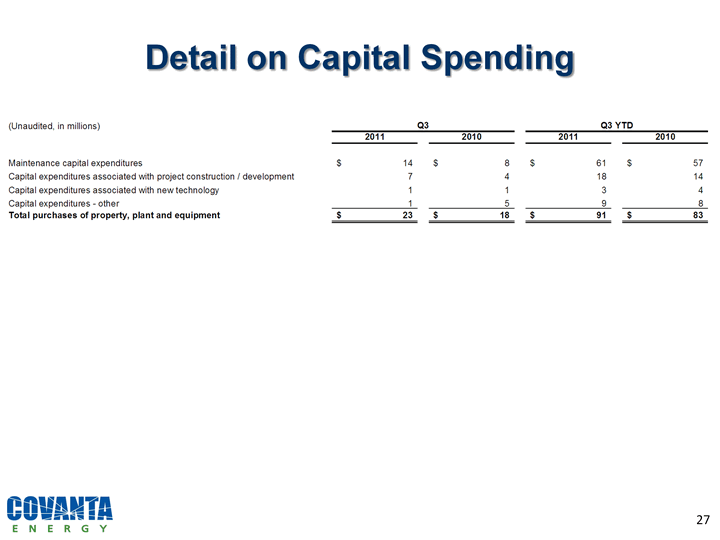
| Detail on Capital Spending |
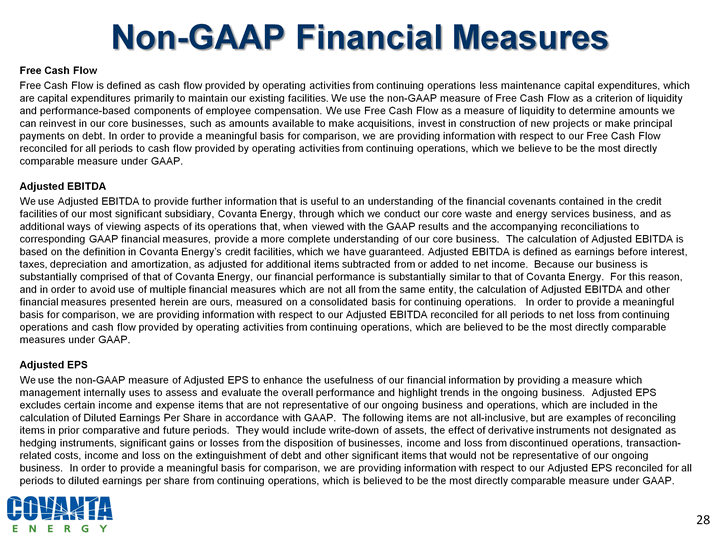
| Non-GAAP Financial Measures Free Cash Flow Free Cash Flow is defined as cash flow provided by operating activities from continuing operations less maintenance capital expenditures, which are capital expenditures primarily to maintain our existing facilities. We use the non-GAAP measure of Free Cash Flow as a criterion of liquidity and performance-based components of employee compensation. We use Free Cash Flow as a measure of liquidity to determine amounts we can reinvest in our core businesses, such as amounts available to make acquisitions, invest in construction of new projects or make principal payments on debt. In order to provide a meaningful basis for comparison, we are providing information with respect to our Free Cash Flow reconciled for all periods to cash flow provided by operating activities from continuing operations, which we believe to be the most directly comparable measure under GAAP. Adjusted EBITDA We use Adjusted EBITDA to provide further information that is useful to an understanding of the financial covenants contained in the credit facilities of our most significant subsidiary, Covanta Energy, through which we conduct our core waste and energy services business, and as additional ways of viewing aspects of its operations that, when viewed with the GAAP results and the accompanying reconciliations to corresponding GAAP financial measures, provide a more complete understanding of our core business. The calculation of Adjusted EBITDA is based on the definition in Covanta Energy's credit facilities, which we have guaranteed. Adjusted EBITDA is defined as earnings before interest, taxes, depreciation and amortization, as adjusted for additional items subtracted from or added to net income. Because our business is substantially comprised of that of Covanta Energy, our financial performance is substantially similar to that of Covanta Energy. For this reason, and in order to avoid use of multiple financial measures which are not all from the same entity, the calculation of Adjusted EBITDA and other financial measures presented herein are ours, measured on a consolidated basis for continuing operations. In order to provide a meaningful basis for comparison, we are providing information with respect to our Adjusted EBITDA reconciled for all periods to net loss from continuing operations and cash flow provided by operating activities from continuing operations, which are believed to be the most directly comparable measures under GAAP. Adjusted EPS We use the non-GAAP measure of Adjusted EPS to enhance the usefulness of our financial information by providing a measure which management internally uses to assess and evaluate the overall performance and highlight trends in the ongoing business. Adjusted EPS excludes certain income and expense items that are not representative of our ongoing business and operations, which are included in the calculation of Diluted Earnings Per Share in accordance with GAAP. The following items are not all-inclusive, but are examples of reconciling items in prior comparative and future periods. They would include write-down of assets, the effect of derivative instruments not designated as hedging instruments, significant gains or losses from the disposition of businesses, income and loss from discontinued operations, transaction- related costs, income and loss on the extinguishment of debt and other significant items that would not be representative of our ongoing business. In order to provide a meaningful basis for comparison, we are providing information with respect to our Adjusted EPS reconciled for all periods to diluted earnings per share from continuing operations, which is believed to be the most directly comparable measure under GAAP. |
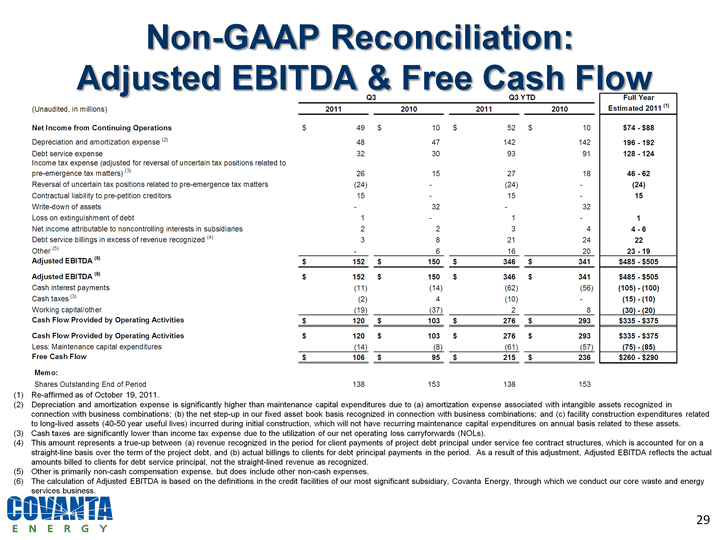
| Non-GAAP Reconciliation: Adjusted EBITDA & Free Cash Flow Re-affirmed as of October 19, 2011. Depreciation and amortization expense is significantly higher than maintenance capital expenditures due to (a) amortization expense associated with intangible assets recognized in connection with business combinations; (b) the net step-up in our fixed asset book basis recognized in connection with business combinations; and (c) facility construction expenditures related to long-lived assets (40-50 year useful lives) incurred during initial construction, which will not have recurring maintenance capital expenditures on annual basis related to these assets. Cash taxes are significantly lower than income tax expense due to the utilization of our net operating loss carryforwards (NOLs). This amount represents a true-up between (a) revenue recognized in the period for client payments of project debt principal under service fee contract structures, which is accounted for on a straight-line basis over the term of the project debt, and (b) actual billings to clients for debt principal payments in the period. As a result of this adjustment, Adjusted EBITDA reflects the actual amounts billed to clients for debt service principal, not the straight-lined revenue as recognized. Other is primarily non-cash compensation expense, but does include other non-cash expenses. The calculation of Adjusted EBITDA is based on the definitions in the credit facilities of our most significant subsidiary, Covanta Energy, through which we conduct our core waste and energy services business. |
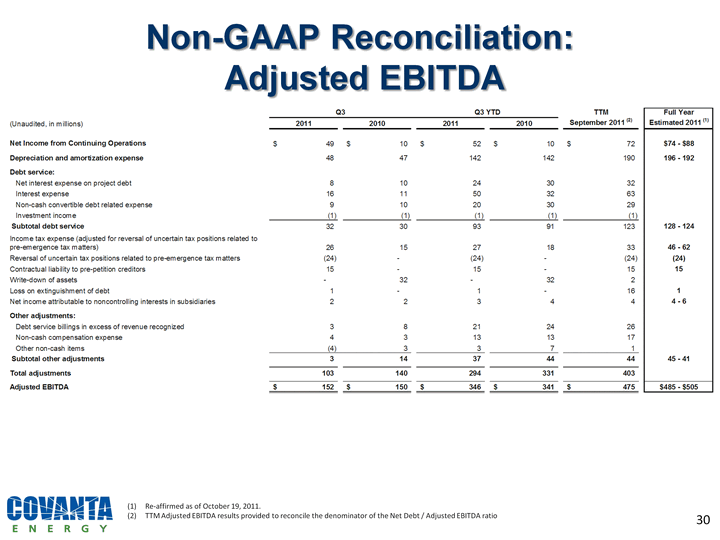
| Non-GAAP Reconciliation: Adjusted EBITDA Re-affirmed as of October 19, 2011. TTM Adjusted EBITDA results provided to reconcile the denominator of the Net Debt / Adjusted EBITDA ratio |

| Non-GAAP Reconciliation: Adjusted EPS Re-affirmed as of October 19, 2011. |
